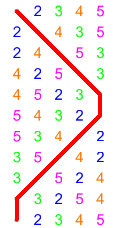Method Toolboxes for ringers
4. Plain Hunt Toolbox
4.1. Plain Hunt explained
The path of the bells can be shown in the form of a line that represents the movement of each bell amongst the others. This line, for historical reasons, is known as the blue line although it is frequently represented by various colours. The diagram (below) shows the path of the treble, marked in red, plain hunting on five bells. It represents one lead. Each bell follows the same path but starts in a different place.
 |
For example, the treble starts by ringing rounds in first place. When Plain Hunt starts it rings in seconds, thirds, fourths and fifths place on consecutive strokes. It rings a second blow in fifths place (know as lying) and then hunts down to the front, ringing in fourths, thirds, seconds and then first place. Plain Hunt comes round when the treble rings its second blow in first place (leading). Now, for example, look at the path of the 5. When Plain Hunt starts it rings a second blow in fifths places and then hunts down to the front, ringing in fourths, thirds, seconds and then first place. It rings a second blow in first place and then rings in seconds, thirds, fourths and fifths place. Plain Hunt comes round when the fifth rings its first blow in fifth place (lying). |
Download the Plain Hunt chart, and look at the path of the other bells. All the bells ring the same line or order of places starting in a different place.
Plain Hunt brings with it a whole new set of terms, which are explained in the Plain Hunt jargon buster.
If you find the diagram of Plain Hunt confusing, you can find out more about how methods are written out.